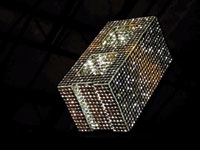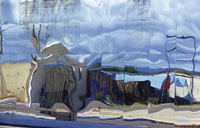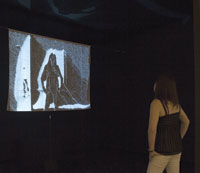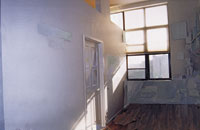Artists
Calling to mind the work of a mad building contractor, Alejandro Almanza Pereda’s precarious work draws attention to the risks inherent in construction and in life. Massive installations made of teetering furniture and lit fluorescent bulbs submerged in water baths that threaten to electrocute artist and viewer alike point to the delicacy of life. And in the current installation, concrete building blocks resting on delicate clear light bulbs suggest the reliance of life on architectural structure, as the power source (a metaphor for life) runs through the blocks, but also life’s simultaneous vulnerability in the face of the massive structure it needs for survival. By thematizing the perception of risk, as in don’t make light of something, a concrete block covered in tiny mirrors and hung menacingly from a revolving motor in the ceiling like a disco ball, the artist highlights the consequences of the choices and actions we make, not only in approaching his work but in our daily lives.
don’t make light of something, 2007, mirror, styrofoam, steel cable, motor, 8" x 16" x 8" Edition of 5, 1 AP. Courtesy of Magnan Projects.
The work of Irit Batsry challenges our perception of reality and the reliablity of memory. Pushing and stretching the boundaries of cinema and photography, her large-scale digital prints are sensual painterly distortions that dislodge our visual expectations and sense of perceptual stability.
Her through the looking series is a meditation on the abandoned. Documenting a defunct events park located in a small town in Northeastern Brazil, Batsry creates a collection of displaced, unidentifiable images and empheral landscapes that oscillate between the documentary and the abstract. Interweaving the formal devices of photography and cinema, these images investigate the way perception is mediated through technology. Part of an ongoing cycle, through the looking includes video installation and photography and is the second installment of material shot by Batsry on Brazilian feature film sets.
blow up (grounded), 2006, digital lambda print on fujiflex, 40" x 68". Courtesy of the artist and Shoshana Wayne Gallery.
Andy Graydon creates site-specific works that are generated from the environment in which they are presented. Employing video, projected light, and sound recorded on site, Graydon constructs installations or “science fiction ecologies” that activate and transform physical space. Mining not the materiality of a space, but the speculative potentials and transformative qualities that circulate in a site, Graydon’s work stretches the perceptual dimension of place and presence. In the process, he situates his audience at the hovering point between existence and displacement, material and media, and real and mediated experience. For displacement Graydon is presenting two site-specific installations, created specifically for the Greenbelt Building, scaffold (361 manhattan avenue) and chora in three.
scaffold (361 manhattan avenue) is a spatially mapped projected light installation that activates the exhibition space, creating a slowing evolving sculpture of visual perception. chora in three is a sculptural sound installation derived from recordings of the site, which are then processed, amplifed, and arranged to react to the dynamics of the space, its current usage, and its hidden potentials.
scaffold (32 NW 5th avenue), (installation view), 2007, Portland Art Center, Oregon. Courtesy of the artist and LMAKprojects, New York.
Daniel Rozin creates interactive installations and sculptures that have the unique ability to change and respond to the presence of a viewer. Although computers are often used, they are seldom visible. Mirrors and mediated perception of the self are central themes for Rozin. In most of his pieces the viewer takes part, actively and creatively, in the performance of his art. Rozin’s work offers us the opportunity to examine our own physicality through a scanner, darkly, as our movements are detected and reproduced by a sensor and projected in pixelated, partially abstracted form before us for our own investigation. In snow mirror the darkened, carpeted chamber into which we step creates a contemplative and relatively private environment, encouraging a deeper meditation, in which the viewer may consider in the fragmented and partial image, at one remove from a standard mirror reflection, the nature of presence and absence, and the fleeting and transient nature of the self.
snow mirror, 2004, computer, custom software, video camera, projector, silk, dimensions variable, Edition of 6. Courtesy of the artist and Bitforms Gallery.
Raphaele Shirley’s work creates a space for the artist and viewer that is a refuge, an imaginary artificial landscape that appears to extend infinitely, created from styrofoam blocks. She reclaims the disregarded leavings that are the refuse of our consumer society in much the way that artists lay claim to disused spaces in the liminal areas between residential and commercial districts in space, and between a now-defunct industrial economic use and the future development of condos in time. elevation in time includes not only the relatively traditional materials of wood, marble, and photographs, but sound, light, and infrared sensors. The technological elements heighten the sense that we are looking onto a kind of futuristic moonscape, a cool and peaceful place of contemplation. By creating this controlled environment with its accompanying highly personal soundtrack, Shirley asserts her claim to place in a way that is both physical and psychological, but she also welcomes us into her world, inviting us to catch glimpses of her history by traveling through her soundscape—and travel we would, if it were installed here as intended, as an elevator cab.
elevation in time, 2007, mixed media: digiprints on Dibond backing, wood, incandescent lights,infrared sensors, marble, speakers, amplifiers, CD players, 8' x 4' x 4'. Courtesy of the artist.
The distortions of memory and the tension between the traces left and the erasure of her presence in the apartments she has occupied may be seen in Eugenie Tung’s painted photographs. Images of places where she has lived with all signs of her presence removed—furniture, clothes, pictures on the wall—are haunting reminders of the transience of existence and clear illustrations of the transient life of an artist forced to move over and over again in search of space in which to live and work. Her process records the frustrations and futility of the search for stability and the perfect home. Any rental property carries the risk of eviction at the owner’s whim, so any move, if it seeks permanence, is inherently flawed. Tung’s efforts to seamlessly eliminate her belongings carry with them the seeds of eventual failure, as handmade brushstrokes will always show against the smooth, shiny emulsion of a photograph and wet paint will buckle the delicate paper, to say nothing of the difficulty in reproducing with different chemical means the exact colors of the original. Her belongings are “evicted” from her art, but their removal, like her many moves, is (intentionally) imperfect.
15 lawton street, #30, home office area, 2006, acrylic on c-print, 3" x 20". Courtesy of the artist.





